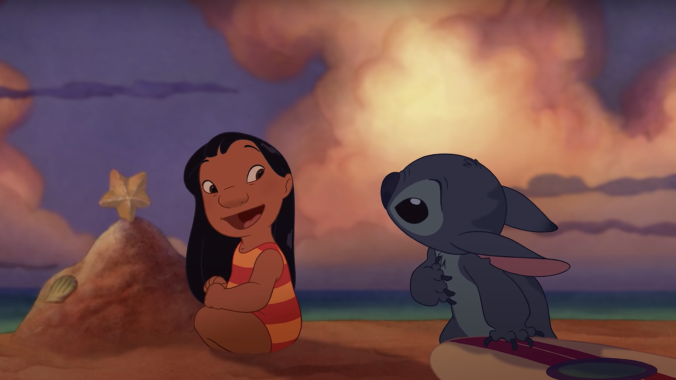Read this: How Lilo & Stitch became the first film to use watercolor backgrounds at Disney in 60 years
The technique had not been used at Disney since the Dumbo days
Aux News Lilo & Stitch
Disney’s Lilo & Stitch remains an underrated gem of the early 2000s animation era. It’s a heartwarming story on family and belonging featuring a rapscallion alien and a headstrong little girl with immense emotional depth and a great soundtrack. What also makes it stand out from the other animated films of its time is the implementation of watercolors in the animation process, which had not been done at Disney in 60 years (as seen in Dumbo) and has not been done since.
A new oral history from Vulture’s Bilge Ebiri sheds light on all the ways Lilo & Stitch excels, and the many ways it could have been changed completely if not for a lack of oversight. What afforded the film’s creators this much leeway was the studio’s location in Florida and the lower allotted budget, which pushed them out of sight and often out of mind of the coastal elite executives, allowing them to take risks that would not be normally permissible, including the ability to implement watercolor backgrounds exclusively.
It all started when creative director Ric Sluiter took a look at the rounded character styles of Lilo & Stitch, and told co-creators and co-directors Chris Sanders and Dean DeBlois, “The perfect complement to your rounded character style would be the watercolor backgrounds that Disney studios did routinely back in the 1930s.”
“What I found out later is that Ric Sluiter greatly regretted having said that!” Sanders says. “Ric came back and said, “Here’s the thing: Watercolor is going to be really difficult. Nobody’s done this since the 1940s. Nobody even knows what kind of pigments or kind of papers—all those things are gone. They would have to be rediscovered. Also, you have to be like a painting ninja to handle watercolor.”
After looking at samples made utilizing watercolor versus opaque gouache (as seen in The Lion King, Aladdin, Beauty And The Beast), two co-directors said: “Nope, we want the watercolor.”
Then began the artists’ efforts to learn how to work with these mediums and figure out the best methods, papers, and pigments.
“We took seven months and we had watercolor workshops and we went out and painted almost every day outdoors,” Sluiter says of the process. “There were maybe eight, nine background artists, and there was only one who knew watercolor: Peter Moehrle. I have to give him a lot of credit there. He taught me a lot.”
The group of background artists even went so far as to track down one of the men who had worked with watercolor at Disney all those years before on films such as Snow White.
“Maurice Noble was one of my heroes, and he was in his 80s. He used to work for Disney in the ’40s and ’50s,” Sluiter says. “He could hardly see. One great technique that he told me about: There were these rocks in Peter Pan, in the Mermaid Cove, with beautiful rock texture. I asked, ‘How’d you get this texture?’ He said, ‘The secret is sea salt—very coarse-grain sea salt.’ So all the lava rocks in Lilo & Stitch—it was all sea salt. It came right from Maurice Noble.”
In the end, Sanders says the Florida team of artists became so “facile” with the use of watercolors, they could create backgrounds at a faster pace than with gouache. Ultimately, this creative choice further solidified the ethos of Lilo & Stitch, which brought classic storytelling to the modern age.
“You can see all the telltale signs of an artist’s hand moving across the picture planes,” DeBlois says. “It complemented the entire mission statement of making the movie: Let’s embrace our B-movie budget and just let it be the style that it aims to be.”
9 Comments
I want the oral history on why John Lassetor fired Chris Sanders from American Dog (Bolt) and effectively from Disney all together. Air out that laundry Chris no one cares what Lassetor has to say anymore!
I’ve read opinions from various animation insiders, including ones who are sympathetic to Sanders, that American Dog was just not working as a feature. I like Bolt myself, but I would dearly love to see whatever WIP materials for American Dog still exist.
Opaque Gouache is going to be the name of my next band
Did you really just use the term “coastal elite?”
What a weird thing to say. Last time I checked, Florida was on the coast.
I would assume the “how” in “how it happened” is that someone decided to make the aesthetic choice to do it and did it. But I didn’t read the article.
Yes, but there’s a bit more to it than that: because watercolor hadn’t been used in animated feature production in over 5 decades, the team working on the film basically had to make all their paints from scratch, and had to rely on the one member of the background crew who had experience in that medium to mentor the others. They even sought out Maurice Noble, then in his 80s and nearly blind, for advice. They were pretty much only able to get away with this because they were working in Florida with a lower budget, and thus out of the way of the executives and bean-counters in California.Not sure if you have time to read the highlights of an article, but I tried.
I always appreciate when Disney tries something off-brand, either in visual style or in writing. Lilo & Stitch is a good example where the end product stands out in a good way.
the surfing scenes are gorgeous